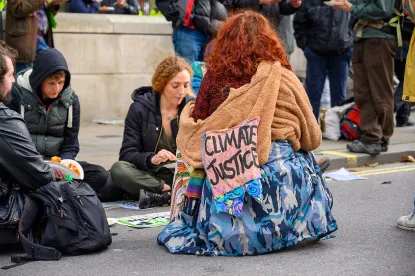Since taking office in January 2021, President Biden has made clear that his administration plans to prioritize environmental justice (or EJ for short).1 The U.S. Environmental Protection Agency (EPA)—which will be tasked with implementing many of the federal government’s EJ initiatives—has recently taken a series of actions that provide insight into how it will effectuate the President’s commitment to environmental justice. Those actions, including EPA’s release of its Draft Strategic Plan for 2022-2026, as well as its unusual recent intervention in a state-level permit proceeding, suggest that EPA intends to spend the next several years zealously pursuing environmental justice in both the enforcement and permitting context.
Members of the regulated community would be well advised to understand—and proactively plan for—EPA’s renewed emphasis on environmental justice, in both their high-level management and day-to-day operations.
BACKGROUND ON EPA’S PURSUIT OF ENVIRONMENTAL JUSTICE
EPA defines environmental justice as “the fair treatment and meaningful involvement of all people regardless of race, color, national origin, or income, with respect to the development, implementation, and enforcement of environmental laws, regulations and policies.”2 Since 1994, when President Clinton first issued an Executive Order directing federal agencies to develop strategies for implementing environmental justice, EPA has taken a variety of actions to incorporate environmental justice into its operations. From the perspective of the regulated community, those actions can be felt in multiple ways. For instance, EJ considerations can affect whether EPA (and state agencies operating under delegations of EPA authority) issues permits authorizing the development of industrial sites in communities which it considers to already have a disproportionate share of such sites. EJ considerations can also be reflected in heightened public participation requirements, and more aggressive environmental enforcement, with respect to projects and facilities in EJ communities.
That said, as an administrative agency, EPA must operate within the authorities granted to it under applicable statutes. In other words, EPA can only do what Congress authorizes it to do. Thus, EPA’s environmental justice goals are limited by what EPA’s specific controlling statutes (like the National Environmental Policy Act, Clean Water Act, and Clean Air Act) and other more general federal statutes applicable to administrative agencies, allow it to do.
EPA’s main source of authority to enforce environmental justice arises from Title VI of the Civil Rights Act, which prohibits recipients of federal financial assistance—including EPA-funded state agencies—from discriminating on the basis of race, color, or national origin in their programs or activities. To that end, EPA’s Title VI regulations specifically prohibit recipients of federal money from, among other things, administering programs and making siting decisions in a manner that has a discriminatory effect.3 EPA’s authority to pursue environmental justice, however, is not unlimited, and ultimately must be grounded in some source of federal law.
PRESIDENT BIDEN’S JUSTICE40 INITIATIVE
EPA’s recent environmental justice push is closely intertwined with Justice40, the Biden Administration’s “whole-of-government” effort to ensure that at least 40% of the overall benefits from Federal investments in climate and clean energy go to disadvantaged communities. Biden’s Executive Order 14008, Tackling the Climate Crisis at Home and Abroad, required a working group to publish recommendations for how to attain that goal. As a result of that exercise, the White House Environmental Justice Advisory Council recommended that EPA develop guidance for targeting enforcement in legacy environmental justice “hot-spots” to reduce combined risks to human health or the environment.4
These hot-spots are most easily identified using EPA’s environmental justice mapping tool, EJSCREEN. EJSCREEN provides users with data on 11 environmental indicators and six demographic indicators to create environmental justice indexes. EPA uses this tool to implement aspects of its permitting, enforcement, and compliance programs.5 Additionally, a new “Climate and Economic Justice Screening Tool” is currently in development as part of the Justice40 Initiative.6 Pursuant to Executive Order 14008, the Council on Environmental Quality was required to create this new screening tool (which may ultimately supplant or supplement EJSCREEN) by July 2021, but it is still in development.
EPA’S PLAN FOR ENHANCED EJ ENFORCEMENT
On 1 October, 2021, EPA released its Draft Strategic Plan for 2022-2026.7 In it, EPA sketched a framework for how it would pursue environmental justice. EPA’s commitments include, by September 2026:
-
Conducting 55% of inspections annually at facilities that affect communities with potential environmental justice concerns.
-
Including commitments to address disproportionate impacts in environmental justice communities in all written agreements between EPA and states and tribes implementing delegated authorities.
-
Addressing environmental justice concerns in 40% of Comprehensive Environmental Response, Compensation, and Liability Act (CERCLA); oil spill; Homeland Security; and Federal Emergency Management Act (FEMA) environmental emergency exercises with EPA participation annually.
Some of the Draft Strategic Plan’s goals are not yet quantified. For example, the Draft Plan sets forth a goal of providing assistance to “XX” number of states, territories, local governments, and communities with environmental justice concerns to take action in response to climate change. The goals are also subject to change, as the Draft Plan has been open to public comment until very recently on 12 November. Regardless, one of the broad signals of the Draft Plan is that EPA intends to increase inspections and enforcement, especially in communities which it characterizes as affected by environmental justice concerns.
EPA’S PERMITTING INTERVENTION IN MICHIGAN
In an attention-grabbing letter issued on 16 September 2021, the Acting Regional Administrator for EPA Region 5 highlighted environmental justice concerns with respect to the issuance of a minor source air permit for a proposed asphalt plant in Michigan. Using EJSCREEN data, EPA determined that the one-mile area around the proposed plant, where the population is disproportionately low income and people of color, exceeds the 90th percentile on 8 of the 11 EJSCREEN environmental indicators.8 As a result, EPA recommended that Michigan’s Department of Environment, Great Lakes, and Energy (MEGLE) go beyond what it already has done in determining that the proposed minor source plant met applicable air quality standards to require a cumulative analysis of projected emissions from the proposed plant as well as nearby industrial facilities; that MEGLE consider using opacity cameras and other continuous compliance measures to ensure that the permittee meets permitted limits; and that the permittee make its environmental monitoring data publicly available (among other measures). EPA also directed MEGLE to assess its own obligations under civil rights laws and policies, including whether civil rights law requires MEGLE to mandate that the permittee consider an alternative site. Thus, while the ultimate permitting decision still rests with MEGLE in this case, EPA’s directives to MEGLE could be interpreted as a threat of potential civil rights enforcement.
EPA’s assertive intervention in a minor source air permitting proceeding, particularly on EJ grounds, is unusual and highlights EPA’s enhanced focus on EJ considerations. Significant questions remain, however, concerning whether MEGLE has the legal authority to impose the additional measures that EPA has recommended.
CONCLUSION
EPA’s recent actions with respect to environmental justice make clear that EPA is committed to paying more than lip-service to its long-standing EJ goals. All persons and entities that are subject to the requirements of federal environmental laws (whether implemented by EPA directly or through delegated state agencies) need to be cognizant of EPA’s renewed focus on EJ enforcement. By proactively planning to account for EJ considerations in their own decision-making processes, members of the regulated community can best achieve positive outcomes for both themselves and the communities in which they operate.
-
See Executive Order 13990, Protecting Public Health and the Environment and Restoring Science to Tackle the Climate Crisis (20 Jan. , 2021); and Executive Order 14008, Tackling the Climate Crisis at Home and Abroad (27 Jan., 2021).
-
Read more here.
-
40 C.F.R. § 7.35(b), (c).
-
White House Environmental Justice Advisory Council Final Recommendations, p. 39 (21 May, 2021).
-
Read more here.
-
Required by Executive Order 14008 § 222(a) to be established by July 2021
-
Read more here.
-
Read more here.





 />i
/>i
